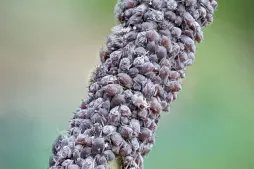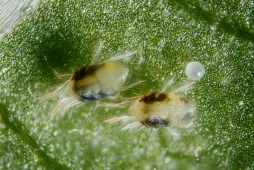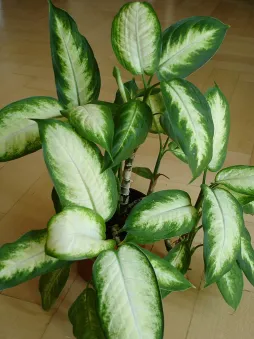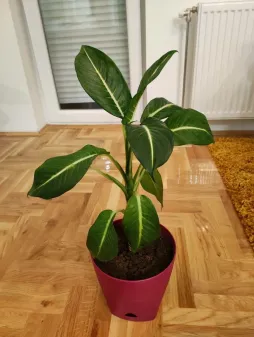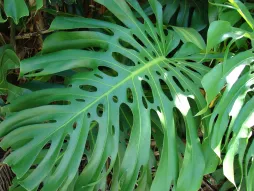Dieffenbachia seguine, the plant that will leave you speechless
Rumor has it that in the West Indies and South America, voodoo priests use Dieffenbachia seguine to silence their enemies. In our latitudes, this plant of the Araceae family is cultivated for its variegated foliage. But it retains its powers.
How to recognize Dieffenbachia seguine?
Dieffenbachia seguine is a sub-shrub with an upright habit. In the wild, this small shrub is no more than two meters high. In pots and indoors, it rarely exceeds 1.5 meters.
Dieffenbachia has no trunk, but a sturdy, unbranched stem. The stem is covered by petioles, which support the leaves.
The thick, lanceolate leaf blades can reach 45 centimetres long and 30 centimetres wide. Green, they are mottled with cream or yellow. Dieffenbachia 'Camilla has cream leaves with green margins, while dieffenbachia Green Magic is dark green with white veins.
Dieffenbachia is grown for its evergreen foliage. But it sometimes flowers, even far from its native forests. A white or greenish spathe surrounding a yellowish spadix then appears.
When the flowers fade, they are replaced by the fruit, a round, red berry. It contains the globular seeds.
Dieffenbachia seguine is entirely toxic. It causes skin irritation when touched. If ingested, it causes swelling of the mucous membranes. It can even cause paralysis of the vocal cords and tongue, hence the name "mute's cane". To avoid accidents, wear gloves when handling the plant and wash your hands afterwards. Keep it out of the reach of children and pets.
Our maintenance tips
You don't need a green thumb to enjoy the magnificent foliage of Dieffenbachia seguine. Regular watering, a draught-free location and a well-drained substrate are all that's needed for growth.
Watering
Water only when the substrate has dried on the surface (one or two centimeters).
Use non-calcareous water, such as rainwater or mineral water, at room temperature. Pour it over the soil, avoiding the foliage.
To prevent root rot, remove any water that collects in the dish or planter.
Spray
Dry air favors the appearance of mites and other pests. Mist the foliage of your Mute cane to prevent invasions and improve hygrometry.
Use non-calcareous water, such as reclaimed rainwater. Tap water is often too hard and leaves marks on the leaves.
Repotting
Every spring, repot your Dieffenbachia seguine to give it more space.
Change is often difficult for plants dieffenbachia seguine. Re-pot your plant when it has colonized its entire container or when its roots are escaping from the drainage holes.
Get a pot with holes larger than the root ball. If you tend to have a heavy hand when it comes to watering, choose a terracotta model. This material promotes even drying of the substrate.
Fill the bottom with clay balls or gravel to promote drainage. Then add a layer of potting soil for green plants. Place your subject in the center of the pot and fill in with substrate.
Water for the first time immediately after repotting to encourage rooting and remove air bubbles.
Fertilization
To promote the growth of your Dieffenbachia seguine, apply fertilizer in spring and summer.
Supplement watering with a houseplant fertilizer to promote the development of your Dieffenbachia seguine.
If you have just repotted, wait six to eight weeks before starting to fertilize.
Cleaning
Dust on leaves interferes with photosynthesis. To make sure your Mute cane gets all the available light, clean its foliage with a clean, damp cloth.
Caution! All parts of the plant are toxic. Wear gloves and wash your hands after touching the foliage.
Caution! All parts of the plant are toxic. Wear gloves and wash your hands after touching the foliage.
Cutting
Cutting is carried out during the strong growth phase, generally in spring and early summer.
Using a clean, sharp tool, remove a stem about ten centimetres long.
Prepare a bucket filled with peat and sand. Plant your cutting in it.
Cover the pot and plant with a transparent plastic bag or cloche. Place in a room with a temperature of at least 20°. Avoid too bright a spot, preferring part shade.
Aerate daily for a minute or two, and mist if the soil dries out.
Diseases / Threats
Information
| Family | Araceae - Araceae |
| Type | Dieffenbachia - Dieffenbachia |
| Species | Mute cane - Dieffenbachia seguine |
| Lifecycle | Perennial |
| Foliage | Evergreen |
| Exposures | |
| Substrat | |
| Planting method |
In pots |
| Categories | |
| Tags |
Beginner Fritillary Toxic |
| Origin |
South America |
| Hardiness (USDA) | 11a |
| Leaf color |
|
| Flower colors |
|
| Fruit color |
|
Discover plants from the same family












